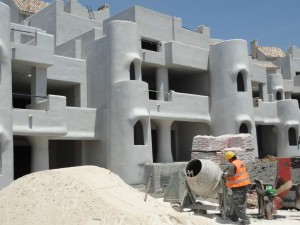 A recent article in Spanish Property Insight stated, “Building land market comes back to life, but recovery is patchy and town planning an obstacle”. Yes, only by looking round the skyline it’s good to see cranes moving to create buildings where people want to live and holiday. Yes, it is patchy, because the builders want to build in the ‘safest’ locations, where people want to live and holiday. There are still shells of developments in poorer locations, far from beaches and social and retail facilities, which were never going to be popular. Developments started there because builders were lent money to build, they were the only sites available and speculative buyers were lent money to reserve them. However, when the crash came, these buyers couldn’t sell on at a vast profit, especially considering the costs of purchase and sale. Too late they found they couldn’t rent the houses as nobody wanted to live there. Also, the costs and taxes on income made it impossible to cover all the running costs. So, they pulled out of the purchase and the whole deal collapsed leaving banks with empty shell apartments in a failed development.
A recent article in Spanish Property Insight stated, “Building land market comes back to life, but recovery is patchy and town planning an obstacle”. Yes, only by looking round the skyline it’s good to see cranes moving to create buildings where people want to live and holiday. Yes, it is patchy, because the builders want to build in the ‘safest’ locations, where people want to live and holiday. There are still shells of developments in poorer locations, far from beaches and social and retail facilities, which were never going to be popular. Developments started there because builders were lent money to build, they were the only sites available and speculative buyers were lent money to reserve them. However, when the crash came, these buyers couldn’t sell on at a vast profit, especially considering the costs of purchase and sale. Too late they found they couldn’t rent the houses as nobody wanted to live there. Also, the costs and taxes on income made it impossible to cover all the running costs. So, they pulled out of the purchase and the whole deal collapsed leaving banks with empty shell apartments in a failed development.
The failure wasn’t of the building; it was of the location. Now we are seeing a rush to buy building land again, in poorer locations because the price is low. Then marketing starts, convincing naive buyers that they should be paying high prices for new, unsnagged properties. People buy new when, with internet research, they’ll find better existing properties, in better locations, as that developer had the pick of those.
Why do they buy new? Because they are provided with a folder with all the information there and easy mortgage finance. As valuers, we see it all the time, where people buy from a developer and then have to sell. They haven’t glossy marketing and a ‘motor-mouth’ agent working for high commission. Banks are only prepared to offer mortgages at a lower % of loan to value. There can be 20, 30 or even 40% price differences in prime locations between new apartments and resales. Resales are where the bargains lie, with the teething problems dealt with by the original buyer. Yes, the new developer will offer to sort anything, for the first year, but it’s the occupier who has the hassle and possible damage, the lost time waiting and arguing for the repairs and then never really feeling that it’s as good as new!
Urban planning should prevent wholesale development of an area and allow for construction of infrastructure. Also, planning should be designed to provide accommodation just for occupiers and not speculators. If speculators were taken out of the land and housing market, then supply would be much more balanced to occupier demand. Each development company cannot know what other companies are planning and so take the risk of buying the land and developing which takes years, all based on historic data of ‘buyer’ demand. Each buyer should be obliged to have the apartment/townhouse/villa occupied for at least one year before they can sell or be fined on an increasing monthly scale. That would stop the speculation.
So, be prudent, both speculators and potential occupiers, research the location carefully and look at everything that’s available. It will take time doing detective work to get all the information. It’s better to spend time now and buy at a good price, instead of being blinkered and spoon fed by a developer’s agent, only to find that you have an instant loss on a property where defects still have to be corrected. Some of the work can be carried out by professionals being paid by you and therefore working 100% for you. Snagging, buildings surveys and valuations can be carried out by an RICS surveyor, working with the physical property and advising the lawyer who is making good the paperwork. You know it makes sense.





